The fuel pressure is checked when the engine idles unevenly, does not develop enough power, or stalls
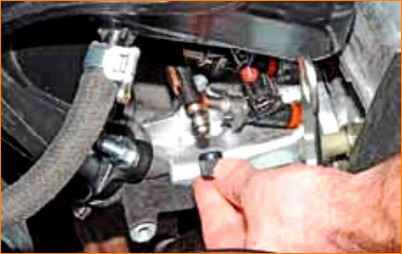
Unscrew the protective cap of the fuel rail diagnostic fitting.
Connect the pressure gauge hose to the diagnostic fitting of the fuel rail.
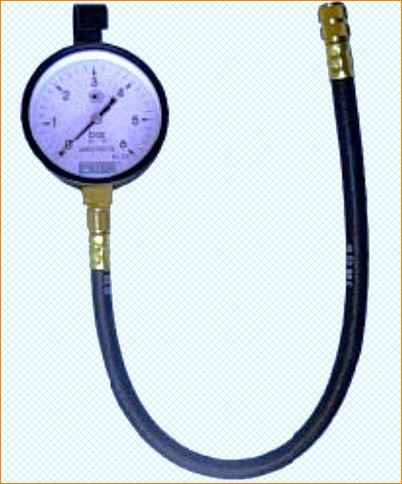
If necessary, the pressure in the fuel rail can be measured with a homemade device, made from a pressure gauge from a foot pump.
Before connecting such a pressure gauge, it is necessary to relieve the fuel pressure.
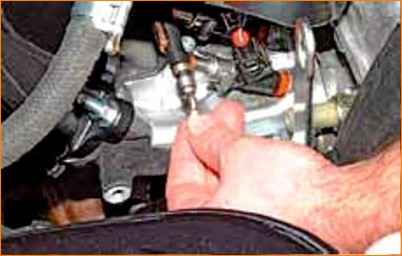
After this, unscrew the spool valve from the fuel rail fitting.
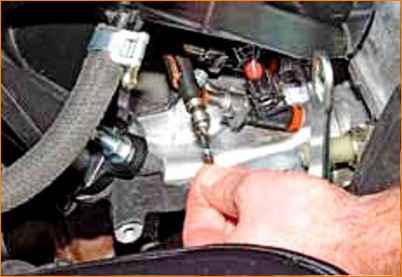
This can be done with a metal cap from the wheel nipple.
To connect the pressure gauge to the fuel rail fitting, use a piece of gas-resistant hose of a suitable diameter.
The ends of the hoses must be securely secured with clamps.
Turn on the ignition.
In this case, the fuel pump will work for a few seconds, wait until the pump stops working, turn off the ignition.
To remove air from the pressure gauge, lower the end of the drain tube into a small container, unscrew the bleeder fitting of the pressure gauge ⅓-½ turn and release excess gasoline pressure from the fuel rail.
This will remove air from the pressure gauge hose.
Turn in the bleeder fitting until it stops.
Start the engine and measure the operating pressure in the fuel rail at different crankshaft speeds.
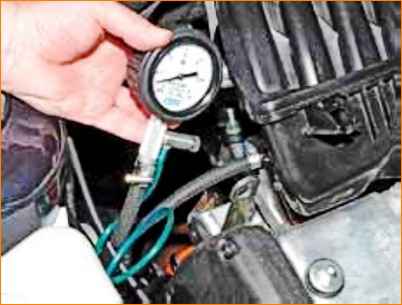
For a working engine it should be in the range of 378-390 kPa (3.8-3.9 bar).
Turn off the ignition.
Having lowered the end of the tube into the container, open the fitting and relieve pressure from the system.
Disconnect the pressure gauge from the diagnostic fitting of the fuel rail.
Screw the protective cap onto the fuel rail fitting.
If the operating pressure in the fuel rail is unstable or higher than normal, then the fuel pressure regulator is faulty.
Low pressure (less than normal) can also be caused by a malfunction of the regulator.
The fuel pump strainer may be clogged, or the fuel pump is not developing the required pressure; to clean the strainer you will need to remove the fuel module.
You can verify that the pressure regulator and fuel pump are faulty by replacing them with known good ones. You can also replace the fuel module assembly.
To check the fuel filter for contamination, you need to remove it, drain the remaining fuel from the filter and blow it through a piece of hose (you can use your mouth).
The resistance to air passage when blowing should be insignificant.
Otherwise, we replace the fuel filter with a new one, which we recommend always keeping in stock.
We check the condition of the fuel module strainer after dismantling and disassembling the fuel module.
If the mesh filter is very dirty, clean and rinse it.
If the fuel pressure in the engine power supply system is low and continues to drop after the pump is turned off, this may be due to leaky connections between the pump and the fuel pressure regulator with the module cover, a faulty pump, or leaking injectors.
To find the cause of the malfunction, turn on the fuel pump again and, after stopping it, completely pinch the rubber hose supplying fuel to the ramp.
If the fuel pressure stabilizes, then the fuel module connections are leaking or the pump is faulty.
If the pressure continues to drop, one or more injectors are leaking.
A leaking injector can usually be identified by the dark color of its nozzle, which contains coked droplets of fuel.
To check the serviceability of the fuel pressure regulator (at low pressure in the rail), connect the pressure gauge hose directly to the outlet fitting of the fuel module cover.
Turning on the ignition, measure the fuel pressure.
If the fuel pressure in the system is more than 4.0 bar, it means that during the previous check the regulator released pressure too rapidly and needs to be replaced.





